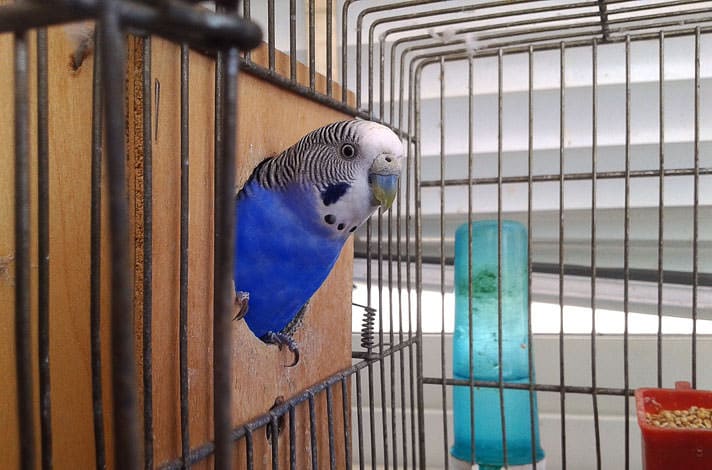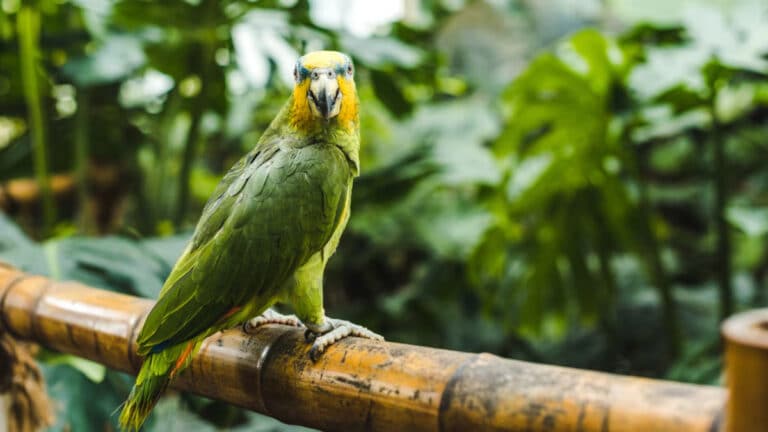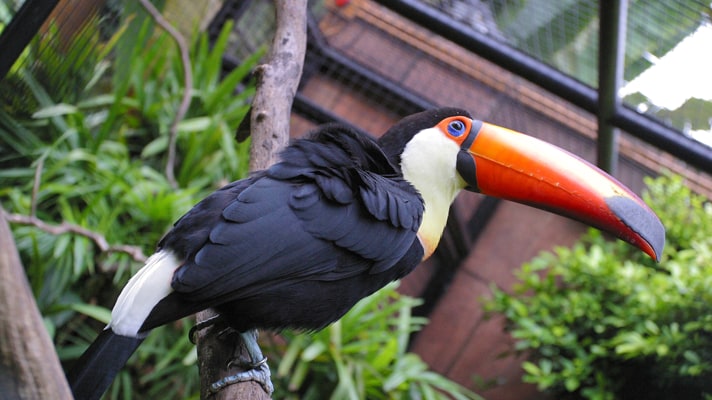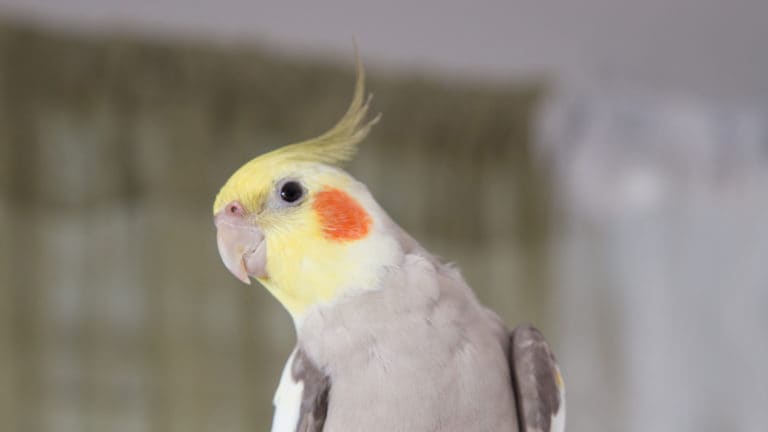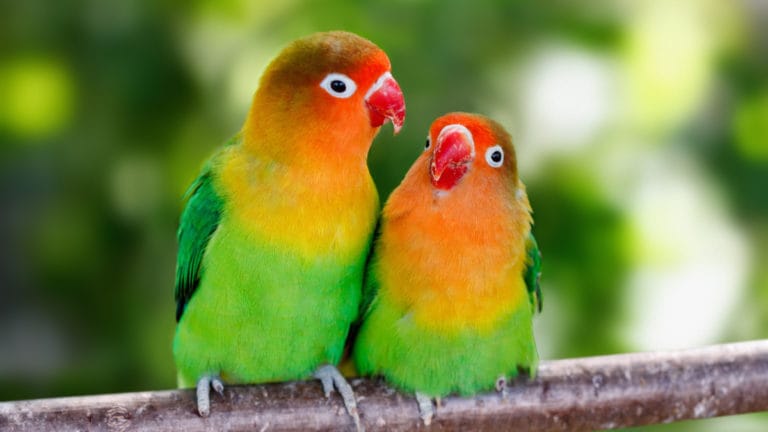Pet birds are extremely clean. They spend most of their time carefully preening their feathers and grooming themselves. However, some bird species can make a big mess, and this is one reason some people consider them to be high-maintenance pets.
Pet birds shed a considerable amount of dander, feather particles, quills, down and feathers each day. This is a normal result of their fastidious grooming habits in addition to molting (the normal growth and replacement of feathers). Also, debris is created from birds chewing and shredding things. Much of what gets scattered on the bottom of cages are food remnants.
Greg Burkett, DVM, an avian specialist who owns Avian Veterinary Services, as well as owner and operator of Birdie Boutique Inc., in Durham, N.C., explained where the mess comes from. “They seem to waste more food than they eat because they rarely finish eating the piece of food they [grab] with their beak; they take a bite or two, or crumble it up if it is crunchy and let the rest fall on the floor or cage bottom. Sometimes they fling food to get it off of their beak, and they will wipe their beak on their perch to clean food from their beak.
Last, but not least to be dealt with, is the fecal matter — the infamous bird poop that our pet birds produce.
Why The Bird Debris?
A greater purpose exists for all of this debris making. Each of these messy behaviors is beneficial to the natural environment in very specific ways, most of which aid in renewing the forests. While molting is important to keep a bird’s feathers in good shape, its purpose is more inconspicuous in the wild.
“The feathers that are molted are used by other animals to make nests, and the nutrients in the feathers are degraded and go back into the earth for plants and microbes to break down and use “this is natural composting,” Burkett said. The food they drop onto the ground also becomes composted.
Burkett said that something even more important happens to the unused food. “Parrots live in the canopy of the forest and have access to foods that ground-dwelling animals cannot reach but really want to eat. So, the food that is dropped is a good source of nutrition for many animals that live lower in the forest.
Most of all, the chewing of plants and trees stimulates new growth and increases flower, nut and fruit production. The bird benefits because the chewing action keeps its beak nicely trimmed.
What about that infamous bird poop? That waste is full of nitrogen and becomes a primo fertilizer for the forest floor!
Danger Of Exposure
Unfortunately for pet bird owners, we don’t need the keratin remnants from feather sheaths, aging pecan particles and other debris to compost our carpets. And our floors certainly don’t need to be fertilized and broken down by nitrogen-rich poop, no matter how glorious it is.
Outside of the wild and inside the confines of human living, the waste builds up quickly, because it is not used nor is it spread out generously over miles. What’s more, people, other pets and the birds themselves can be harmed from a large accumulation of waste and dirt. And so we must become the proverbial slaves to our pet birds and be vigilant in our cleaning practices. The results of not keeping a home environment clean can be bad for people and animals alike.
Health risks can arise due to molds and bacteria that silently proliferate from the accumulation of waste. These microscopic dangers become airborne when a pet bird flaps it wings and engages in other activities in and around the cage. Fine particles are spread throughout the home via air currents, traffic, air conditioners and heating vents. Occupants can suffer a host of respiratory infections from breathing these in.
“The build up of ammonia from the poop can also cause respiratory disease and can cause eye lesions from the chemical reaction on the cornea of the eye,” Burkett said. “The ammonia can also cause sinus inflammation, inflammation in the mouth and in the lungs.
Although rare, avian transmissible diseases exist that are protozoal, fungal, bacterial or viral in nature, and these can thrive in unclean conditions. At particular risk are the very young, elderly and those with compromised immune systems. Psittacosis, Salmonellosis, arizonosis and colibacillosis (E.coli) are the most common of these infections. Other diseases of significance are Giardia, Newcastle disease, cryptosporidiosis and histoplasmosis.
Bird-Keeper’s Lung
One condition is commonly known as bird-fancier’s lung, or bird-keeper’s lung. It is technically known as hypersensitivity pneumonitis (HP) and is also called extrinsic allergic alveolitis (EAA). It is caused by a hypersensitivity to the proteins found in feathers, dander and feces when breathed into the lungs.
Hobby bird breeder Kelli Dowdell of Indiana knows about this disease all too well. Her boyfriend’s mother contracted the disease from helping her husband care for his pigeons. The debilitating disease was caught too late and has grown worse every year since. Dowdell offered some valuable advice: “Anyone with a bird — no matter if it’s one little parrotlet or a big macaw — when you go to a doctor, tell them you have a bird. It’s important that this is in your records. This way, if you end up with any issues and they can’t find a cause for it, they know you have birds and they can then test you appropriately.
When left unchecked, the disease can lead to life-threatening conditions. One of the most serious of these conditions is pulmonary hypertension, which, in turn, can lead to chronic obstructive pulmonary disease (COPD), heart-valve problems and congestive heart failure.
Mess By Bird Species
Although all pet birds have some messy habits, some species are considered messier than average. Angie Johnson, an avian specialist who owns a pet store in Minneapolis, Minn., said, “Lories, lorikeets and toucans are messier than usual because they eat mostly fruits. These birds fling fruit particles everywhere. Also, since they eat a very liquid diet, their poop tends to be runny, which dries hard, like cement.
“Budgies and other smaller birds are messier than usual, as well, because they eat a lot of tiny little millet seeds, and the hulls get everywhere. Plus, they are most inclined to fly around their cages, and the resulting wind blows the little hulls out of their bottom tray and all over the room.
Johnson also pointed out that African greys and cockatoos are also house-cleaning challenges because they are very dusty birds. “Their dust settles all over everything in the house, unless you have an air purifier to remove the dust.
Where To Begin With Bird Cleaning
So how do bird owners grapple with the daily grind of cleaning? Techniques and strategies vary greatly from owner to owner. One day, I received a picture on my cell phone from a fellow bird owner sporting what she said was a very complex tool to achieve the task of getting poop off of her cages; it was a screwdriver.
The key to spending the least amount of time and yet being the most effective with your cleaning is to establish a daily routine and to consistently keep up with a weekly one.
You probably don’t want to spend hours outdoors hosing down cages like I used to with my hose, or get tennis elbow like my friend using her handy screwdriver. Today’s bird owner is lucky because many choices of bird-safe products are now available to make cleaning a snap.
First choose a few tools, but leave the screwdriver in the garage. You may want more than just paper towels in your cleaning kit, as these will not get you very far very fast.
Grates and cage flooring need to be scrubbed. A stiff, nylon scrubbing brush can help with that, as can brushes and scrapers designed to fit around the curve of the perch. Some people like to use a toothbrush for those hard-to-reach nooks and crannies.
Another brush you may need is a bottle brush if your bird uses a water bottle. Think about replacing those costly paper towels with something more effective, such as a microfiber cloth or a washcloth for wiping down your cage and spot cleaning.
Wood perches are porous, which can make them a challenge to clean. Every now and then, it’s good to sand them down with a piece of sandpaper in addition to washing them.
Lastly, choose a cage liner. Newspapers, butcher paper, paper towels or pre-cut cage liners are often used to line cage floors so that you don’t have to scrub the cage tray every day. There are also bird-safe litters, which allow you to just scoop out the droppings as necessary. The goal is to keep the poop from drying on the cage, grate or perch in the first place.
Cleaning Solutions
You have a lot of great options to choose from for cage cleaning besides hot water and dish soap. My favorite products are the enzymatic cleaners that immediately break down waste so it can be wiped right off. A handy thing to have around is a natural, all-purpose cleaner and degreaser.
Aside from a cleaner, a disinfectant is necessary on occasion to combat germs. Many natural alternatives also can be used for cleaning a bird cage and its surroundings. Grapefruit-seed extract is a mild, natural anti-microbial, and products made from it are a safe choice.
Other common household products that are safe to use around birds are lemon, baking soda, club soda, hydrogen peroxide (as an alternative to bleach), cornstarch, as well as mineral and olive oils.
A bird enthusiast’s best friend and most valued piece of equipment is the vacuum cleaner, hands down. Yes, there will be vacuuming! So opt for a durable one, and use a high-efficiency allergen filter; otherwise you will blow much of your dirt around, not clean it up. Shop vacs are used quite often in multiple bird homes to pick up discarded food, remnants from chewed-up toys and other debris that would otherwise harm a regular home vacuum.
Many people like keeping a steam cleaner handy not just for their furniture and floors, but for the cage. A nifty time-saving trick is to toss your bird’s dishwasher-safe bowls and cage accessories in your dishwasher for a good cleaning and sterilization.
One of the most important pieces of equipment a bird owner can have in the home is an air purifier. It keeps dust down to a minimum, protects your electronics and, most importantly, protects you and your pet’s lungs by purifying the air.
The goal is to spend the least amount of money, time and energy on cleaning as possible so that we can spend it on something more important — fun with our birds! To do this, develop a good daily routine that is easy for you to adhere to. Choose tools and supplies that you are comfortable with and will be apt to use. Simplify your cleaning chores as much as possible, and figure out the best time to do them each day. Your cleaning habits should become as routine as brushing your teeth.
Daily Cleaning Routine
A typical daily routine includes:
* Changing cage liners
* Spot cleaning the grate, cage, perches and toys with bird-safe cleaners.
* Throwing out uneaten food items that are be apt to spoil after a couple of hours
* Washing and disinfecting the soft food dish and water dish
* Sweeping and vacuuming around the cage area
* While tidying up each day, take time to check out a few things. Examine rope perches for frays, as well as other perches and toys for damage that could lead to an injury to your bird. Also check the cage for wear and tear, rough or sharp edges and for any rust.
A lot can be learned about your bird’s health by examining the mess found on the bottom of its cage. Check the condition and amount of the loose feathers, the appearance of the feces, the amount of food waste (which indicate how much the bird is eating, as well as what it is eating), for any chewed-up debris (to see what the bird is getting into), and check for any regurgitation or vomit in the cage, which warrants a call to your vet.
Weekly (Or Biweekly) Cleaning Routine
A typical weekly or biweekly routine may include the following:
* Removal and cleaning of all perches, toys, dishes and other accessories from the cage
* A thorough cleaning of the cage (Remember to rinse and wipe things off well after any heavy-duty cleaning)
* Disinfecting the cage and accessories to kill any possible microorganisms that may cause infectious disease
* Cleaning filters and disinfecting any humidifiers
Many people joke about being slaves to their pets. But they don’t mean it literally. They mean to say that they are slaves to their love for them. You should never feel like you’re slaving away when you are cleaning up after your pets. Emily Strong, vet tech and co-founder of the Austin Parrot Society in Texas, sends a wise message to us all:
“I think it’s really important to let people know that they don’t have to be perfect. A lot of people get a bird and then start reading about these massively high standards that people hold themselves and other bird owners to, and they feel overwhelmed and inadequate.
“Then they get stressed out trying to live up to those standards. [They] feel like they’re failing, feel guilty, start to resent the bird, and they ultimately end up rehoming it — when, in reality, they were probably doing just fine.
I don’t know if I’ll ever get my friend to give up her screwdriver. She says that we can laugh all we want, but it gets the job done. And she’s right. Her bird room sparkles and everyone’s happy. That’s why you need to pick and choose supplies that you enjoy, feel comfortable with and that work for you.
What good are fancy mops if they stay in the closet because you don’t like how they feel, or cleaners that sit in a cabinet because you don’t like the way they smell?
As for me, changing my supplies and habits has not only allowed me to put down my hose, but I am saving money and saving something much more precious; time with my pet bird.
Looking for a name for that new bird in your life? Check out our list of top bird names.
By: Rebecca Stout
Featured Image: Via Pixabay
Share:
